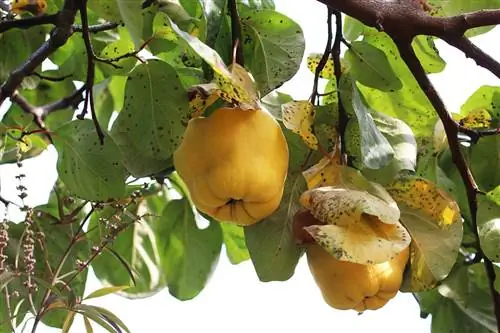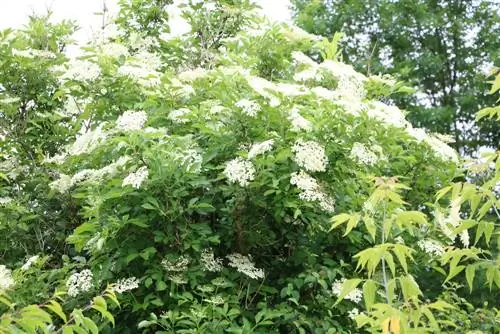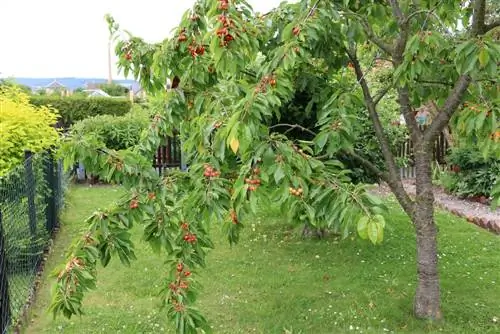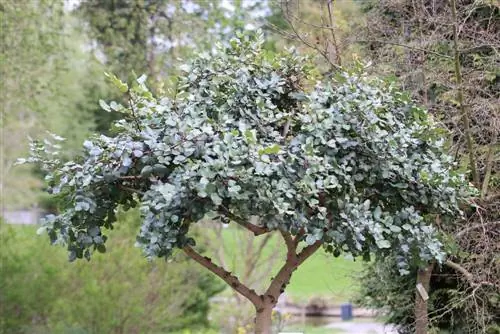- Author admin [email protected].
- Public 2023-12-17 03:39.
- Last modified 2025-01-24 12:45.
There are numerous fruit trees that self-pollinate without any problems and therefore save a lot of space in the garden, on the terrace or in the greenhouse. We introduce you to 20 species in detail.
Pome fruit: 6 self-pollinators
Chokeberries (Aronia)
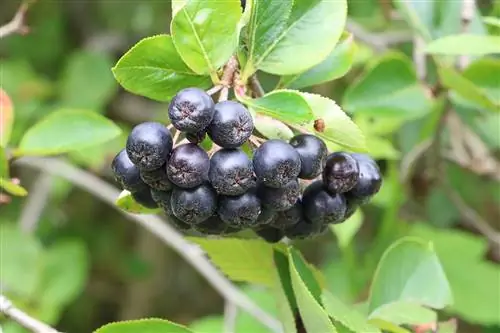
- all 3 species produce edible fruits
- Growth height: up to 250 cm
- shrubby growth, upright, deciduous, dark green foliage
- can be trained as a standard fruit tree
- Flowering period: May to early June
- single double panicle flowers, white
- Harvest time: end of August to mid-October
- Fruits black, round, extremely rich in vitamins, are often eaten by birds
- sour aroma
- Self-pollinator attracts numerous pollinator insects
- sunny to partially shaded, sandy, dry, fresh, well-drained
- hardy
Edible rowan 'Edulis' (Sorbus aucuparia 'Edulis')
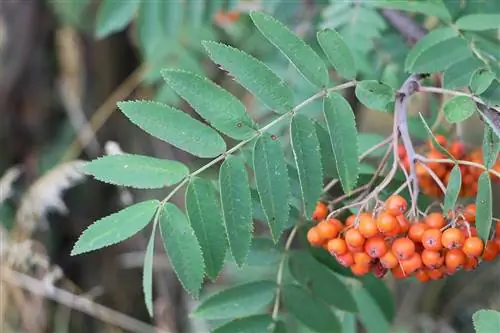
- Growth height: 600 to 1,500 cm
- fast growth, slender, multi-stemmed, pyramidal crown, deciduous, dark green foliage
- Flowering period: May to mid-June
- single-filled umbels, white, rich in flowers
- Harvest time: end of August to beginning of November, first frost intensifies the taste
- Fruits are edible, pleasantly sour taste, orange or red, extremely rich in vitamins, are often eaten by birds
- sunny to partially shaded, solitary position, undemanding to soil
- hardy
Serviceberry (Sorbus torminalis)
- Growth height: 700 to 2,500 cm
- upright growth, dense, round crown, attractive autumn color, summer green, intense green foliage with bluish underside
- Flowering period: May to mid-July
- single double panicle flowers, white, small
- Harvest time: from October
- Fruits reddish to brown with white dots, apple-shaped, quite small, overripe fruits popular with birds
- Cooking fruits before eating
- Taste is reminiscent of marzipan or almonds
- sunny to partially shaded, avoid s alty soils, dry, fresh, nutrient-rich, prefers lime, permeable
- needs winter protection
Medlar (Mespilus germanica)
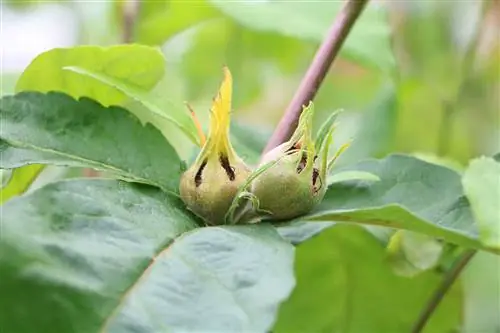
- Growth height: 500 to 600 cm
- crooked growth, wide crown, summer green, intense green foliage
- Flowering time: end of April to mid-June
- single double flowers, on short shoots, white, large
- Harvest time: end of October to end of November
- Fruits orange-brown, spherical, hairy, covered with small warts
- sweet aroma, fine acidity
- sunny to partially shaded, nutrient-rich, calcareous
- hardy
Quince (Cydonia oblonga)

- Growth height: 400 to 800 cm
- shrubby small tree, upright, spreading crown, summer green, dull green foliage
- Flowering period: May to mid-June
- single double flowers, white, pink, large
- Harvest time: October, check ripeness
- Fruits yellow, large (up to 500 g), pear-shaped, extremely rich in vitamins, covered with tannin-containing fuzz
- sour-sweet taste, intensely bitter peel
- wash and heat before consumption (removes bitter taste of the peel)
- sunny to partially shaded, moist, fresh, deep, nutrient-rich
- hardy
Speierling (Sorbus domestica)
- Growth height: 400 to 3,000 cm
- short-stemmed, wide, crown round, summer green, shiny green foliage
- Flowering period: May to June
- single-filled umbels, white, rich in flowers
- Harvest time: September to the end of October
- Fruits red-yellow to olive brown, the shape is reminiscent of small apples or pears, quite large
- attracts pollinator insects and birds
- Bart taste, much more tasty due to processing
- sunny to partially shaded, fresh, nutrient-rich, well-drained, does not tolerate s alt
- hardy
- tolerates heat very well
7 self-fruitful stone fruit trees
Apricot (Prunus armeniaca)
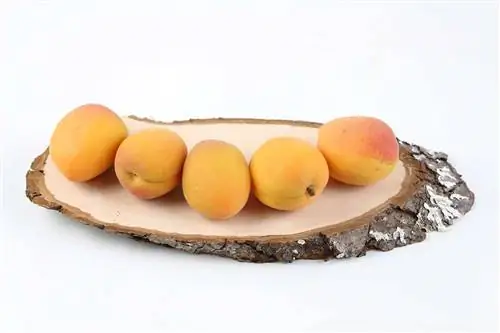
- also known as apricot
- Growth height: 500 to 1,000 cm
- strong growth, wide crown, summer green, green foliage
- Flowering time: March to April
- single double flowers, standing alone or in pairs, white, pale pink
- Harvest time: mid-July to early September (at the latest)
- Fruits light yellow, orange, reddish, round, smooth, juicy, size depends on variety
- aromatic taste, sweet
- attracts pollinator insects
- sunny, humus, normal, permeable
- hardy, late frosts sometimes problematic
Note:
If you want to cultivate the cherrycot (apricot and cherry hybrid), you don't need any pollinators either. They fertilize themselves easily.
Fig (Ficus carica)
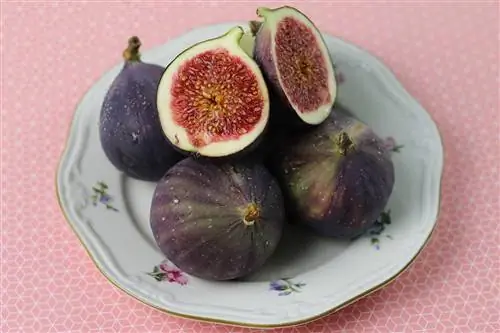
- Growth height: 250 to 500 cm
- Growth habit depends heavily on the variety, usually wide crown, twisted or bent trunk, summer green
- forms lovely milky sap in all parts of the plant except the fruits
- Flowering time: March to mid-August (strongly dependent on climate)
- inconspicuous flowers
- Harvest time: mid-August to end of December
- Fruits in green to purple color, soft flesh, characteristic shape
- sweet aroma
- sunny, loamy, loose, nutrient-rich, sour
- hardy, winter protection recommended
Elderberry (Sambucus)
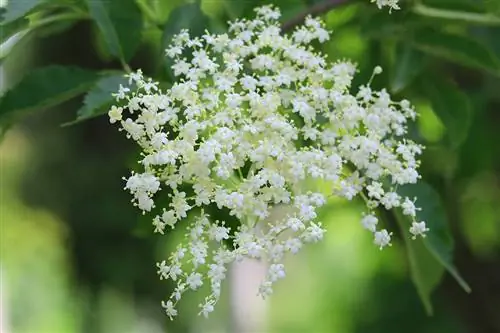
- Growth height: 100 to 1,500 cm
- loose growth, upright, summer green, dark green foliage
- Flowering period: June to mid-July
- single double panicle, umbrella racemes or terminal flowers, white
- Harvest time: end of September to mid-October
- Fruits red, blue or black, round, small
- tart aroma, sometimes bitter, sweet aftertaste
- Flowers also edible
- attracts pollinator insects and birds
- sunny to partially shaded, nutrient-rich, moist, normal, well-drained
- hardy
Peach (Prunus persica)
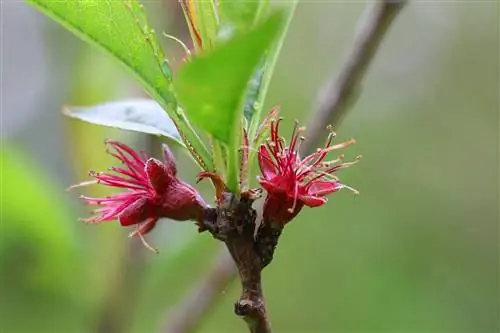
- Growth height: 100 to 800 cm
- well-branched growth, upright, crown mostly close to the ground, deciduous, medium green foliage
- Flowering period: April to mid-May
- single double flowers, fivefold, yellow, pale pink, red
- Harvest time: end of July to beginning of September
- Fruits hairy, round or flat, juicy, greenish or yellow, usually red sunny side
- sour-sweet taste
- sunny to partially shaded, humus, fresh-moist, well-drained
- hardy
- Apricots (Prunus persica var. nucipersica) can also fertilize themselves
Plum (Prunus domestica)
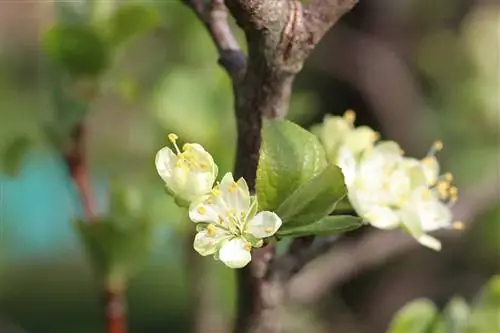
- Growth height: 600 to 1,000 cm
- medium growth, sparse, summer green, intense green foliage
- Flowering period: April to mid-May
- umbelous inflorescences, 2 to 3 flowers per inflorescence, white, white-green, yellow-green
- Harvest time: July to mid-October (highly dependent on variety)
- Fruits yellow-greenish, yellow, reddish, purple, blue, blue-black, purple, black, round or ovoid, smooth skin
- sweet to sour aroma (depending on variety and ripening time)
- sunny to partially shaded, humus, fresh-moist, well-drained
- Pollen donor
- hardy
Note:
All plum subspecies such as plums and mirabelle plums also belong to the self-pollinators. These can be recognized by the botanical name Prunus domestica subspecies.
Sour cherries (Prunus cerasus)
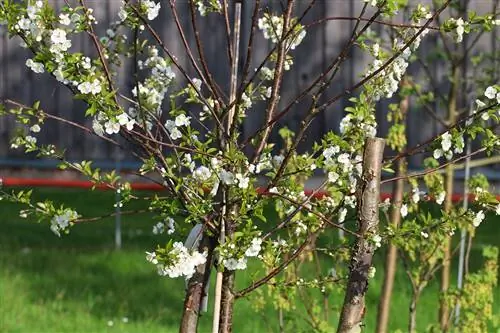
- Growth height: 100 to 1,000 cm
- well-branched growth, upright, slightly drooping, deciduous, medium green foliage
- Flowering period: April to May
- single double umbel flowers, white
- Harvest time: 4th and 5th cherry week (July 2nd to July 24th)
- Fruits red or dark red, roundish, juicy
- mild acidity in taste, tart to spicy
- sunny to partially shaded, humus, fresh-moist, well-drained, nutrient-rich
- hardy
Sweet cherry 'Lapins' (Prunus avium 'Lapins')
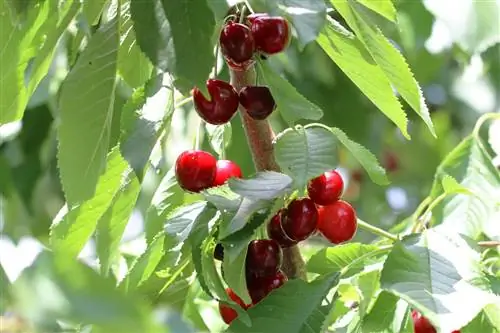
- one of the few self-pollinating varieties of the species
- Growth height: 300 to 600 cm
- compact growth, steep, weakly branched, deciduous, soft green foliage
- Flowering period: April to May
- single filled, radial symmetry, white
- Harvest time: 6th and 7th cherry week (July 26th to August 20th)
- Fruits dark red, large, juicy
- sweet in taste
- sunny, normal, transparent
- hardy
2 types of soft fruit
Currants (Ribes species)
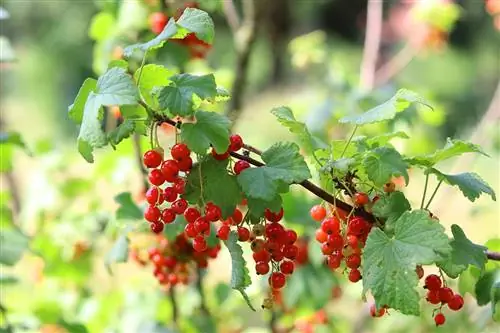
- Growth height: up to 150 cm
- upright growth, small tree, some species form thorns, summer green, intense green foliage
- Flowering period: May to early June
- simple double, in umbellate, racemose or umbrella-like inflorescences, white, greenish, yellowish, red, purple
- Harvest time: from St. John's Day (June 24th) to the end of August (strongly dependent on species and variety)
- Fruits red or black, round, small
- Taste depends on type and variety
- sunny to partially shaded, nutrient-rich, humus
- hardy
Black mulberry (Morus nigra)
- Growth height: up to 1,200 cm
- upright growth, densely branched, decorative, rounded crown, summer green, dark green foliage
- Flowering period: May to mid-June
- inconspicuous flowers, yellowish color
- Harvest time: July to mid-August
- Fruits in dark purple or black, shape reminiscent of blackberries
- sweet and sour aroma, spicy character, intense
- sunny to partially shaded, normal, prefers limestone soils, well-drained
- hardy, winter protection or winter quarters required in particularly cold locations
5 exotics presented
Pomegranate (Punica granatum)
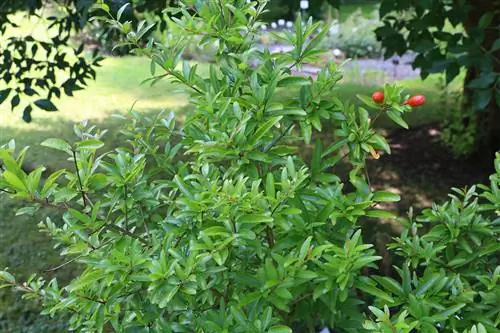
- Growth height: 250 to 500 cm
- bushy growth, upright, thorny, summer green, green foliage
- Flowering period: June to September
- single bell flowers, white, yellow, red
- Harvest time: September to mid-October (only from the 2nd year)
- large, red capsule fruits, filled with numerous seeds, juicy, round, juice rubs off
- sunny, sandy, loamy, fresh, permeable, loose, requires a high proportion of minerals
- hardy down to -5°C, hibernate in winter quarters
Kaki (Diospyros kaki)
- Growth height: 1,000 to 2,000 cm
- Growth is reminiscent of apple trees, scaly bark, upright, deciduous, dark green foliage with light green underside
- Flowering period: May to June
- radially symmetrical flowers, yellowish, greenish, inconspicuous
- Harvest time: end of September to end of October
- large fruits, shape and color depending on variety or subspecies, mostly yellow, orange, red, very rich in vitamins
- furry, needs to ripen, then tart to sweet (depending on ripeness)
- sunny to partially shaded, sheltered loamy, humic, deep, does not tolerate lime, rich in nutrients
- hardy down to -15°C, winter protection may be necessary in cold regions
Pomelo (Citrus maxima)
- Growth height: up to 300 cm
- bushy growth, upright, sprawling, evergreen, with thorns in leaf axils, light green foliage
- highly variable flowering time
- single or in ears, white
- Harvest time strongly depends on flowering time (it sometimes fails depending on the temperature)
- Fruits green to yellow in color, round, very large (up to 20 cm in diameter), extremely rich in vitamins
- Taste fundamentally bitter with subtle sweetness or acidity
- sunny, well structured, permeable, with drainage
- not hardy, won't survive even the slightest frost
- only in containers
Yuzu (Citrus junos)
- Growth height: 150 to 300 cm
- bushy growth, upright, thorny, evergreen, intense green foliage
- Flowering period: May to early June
- simple, white
- Harvest time: October to December
- Fruits intense yellow, roundish, extremely rich in vitamins
- sunny, partial shade tolerable, protected, well structured, permeable, with drainage, nutrient-rich
- hardy down to -12°C, can be planted in suitable locations, otherwise only in containers
Lemons (Citrus limon)
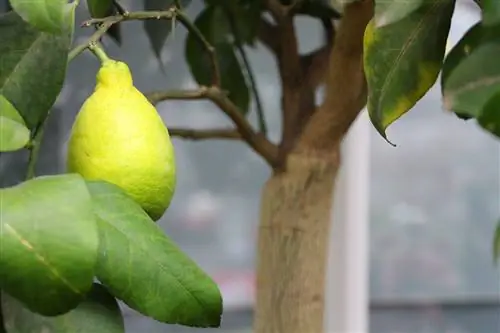
- Growth height: 400 to 500 cm
- bushy growth, upright, fast-growing compared to other citrus species, evergreen, green foliage
- Flowering period: May to mid-August
- unfilled individual flowers, white, intense scent, sometimes even putrid
- Harvest time: September to the end of November (ripeness depends on size)
- high yields possible
- Fruits sunny yellow, fist-sized, oval, elongated
- intensely sour taste
- sunny, ideal south-facing, protected, high-quality citrus soil recommended for fruit trees, humus, permeable
- not hardy, winter protection or winter quarters necessary

